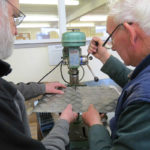If you want to have a Shed which can support 30-50 men with a social, workshop, kitchen, toilets and storage area then we advise a minimum of 250 square meters as your foot print or bigger. Groundfloor with good access somewhere so you can get in long pieces of timber etc. You might also want an outside area for a Polytunnel to grow your veg and flowers. You might want but it’s just not available, so you might have to change your plans in the short to medium term. Who knows what the future holds in 15 years. We also think it’s important to have your shed on a good transport route as in the village centre. This way people can get to you and also the community can see you, get to know you and support you with commissions to do for them. You will have to derive some income to keep your shed open and running.
Importantly you need to have a building with no rent or a peppercorn rent of no more than £100,00 per year. The majority of 1500 Sheds in the world run like this. Speak to your local councils for their ‘surplus to requirement’s’ list of buildings. If you do have your council support they should apply something called, ‘a community benefit formula’ to the commercial rent. This will reduce the rent to the zero or as in many councils the £100 per annum. Your Shed’s purpose will tick most of the Scottish Councils, Scottish Governments and the World Health Organisation boxes. You are helping them achieve their aims. Have a look at the Social Return on Investment (SRoI) document we did on Scotland’s first Men’s Shed in Westhill, Aberdeenshire. (see Member Resources) It made a 10:1 return on the investment. No wonder the Australian government support their national Shed Association and set up support for Sheds, it saves them millions. The best investment around.
Approach your local agencies to ask for help finding suitable premises for your Men’s Shed, if you haven’t already. e.g. Churches, CVS, Voluntary Action, Third Sector Interface (TSI), Community Planning Dept., Council and Community Development Team.
The Community Asset Transfer (CAT) process is another way of getting a building or land for your Shed. Community Asset Transfer involves the transfer of management and/or ownership of land and buildings from a public sector body to a community-based organisation, eg: a local charity, community interest company or industrial and provident society.
Many Scottish Sheds have got their premises through this process. The Scottish Community Empowerment Bill created this opportunity for our communities and you can see the related information on the Scottish Governments website: https://www.gov.scot/community-empowerment
CAT Transfer options
A range of agreements can be entered into to facilitate the transfer of an asset to a community-based organisation – but the most common form is long a long term lease (20+ years) rather than straight out ownership.
Often, local authorities (this also includes the Police, Canals, Scottish Fire and Rescue Service etc but not the Military of Defence) can be approached for buildings in their care.
Checklist for Shedders
Any voluntary or community group interested in Community Asset Transfer
should consider a number of things by way of preparation:
• Gather evidence to show how the community and local people will benefit
from the transfer
• Gather evidence of community support for the transfer – community consultation
• Check to see if your local authority has an Asset Transfer Strategy or CAT department and if there have been other Community Asset Transfers nearby from which you can learn
• Solicit assistance or develop a business plan that demonstrates the financial
viability of your plans – you can get specific assistance from The Community Ownership Support Service – COSS. They have representatives all over Scotland who will guide you through the process for free
• Check that land and buildings in question really are assets and not liabilities – for example, they are liabilities if they cannot generate enough income to fund repairs, maintenance and ongoing operational costs
This process is a perfect fit for Scottish Shedders as they use their existing skills often from their work life to fix the building at a fraction of the cost of using outside contractors. If this interests you give us a call to discuss in further detail. The one key step in this process is once you are a constituted group with charity status and you have found a building you want for your Shed you MUST formally write a note of interest and send it to the ownership body of that particular building.
If it is not in writing and only verbal the whole CAT process can not start.





